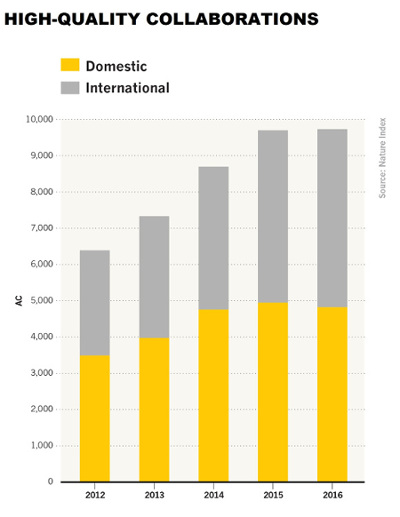
Credit: ALLSTAR Picture Library / Alamy Stock Photo
Charting China's rising dominance in science
The country's research contribution is continuing to overtake other nations.
21 July 2017

ALLSTAR Picture Library / Alamy Stock Photo
China’s total number and global share of articles included in the Nature Index has increased since 2012. This upward trend corresponds with data from the larger Web of Science (WoS) database. The country’s global share of articles, as well as those that are highly-cited, more than doubled between 2005 and 2015.
Over that decade, China increased its global share of articles in 14 fields tracked by the WoS.

Nature Index
China's number of articles in high-quality journals included in the Nature Index has increased unlike those of the United States and Japan. Full size image
Nature Index
China has also grown its share of articles in the index, as the United States reduces its share. Full size image
WoS
China's share of highly-cited papers has grown faster than its share of total articles indexed in the WoS. Full size imageThe number of articles Chinese scientists published with international co-authors in top journals also increased each year since 2012. By 2016, international collaborations comprised more than 50% of the country’s articles in the index.

WoS
China’s global share of articles increased in 14 fields tracked by the WoS between 2005 and 2015. Full size imageWhile international papers make up a significant portion of China’s high-quality research, this level of international co-authorship does not extend to all papers published in China. The country’s share of articles with international co-authors indexed in the WoS remains below 25%.

WoS
China's share of international papers in the index has increased since 2012 and surpassed domestic output in 2016 Full size imageChina’s international collaboration rate remained stable between 2000 and 2012, sitting below 20%, but it had increased to 24% in 2016.

InCites
The percentage of Chinese papers with international coauthors in WoS has increased since 2010. Full size imageYue Weiping, a data analyst with Clarivate Analytics, said the slower growth rate in papers from international collaborations was because China’s overall research output had grown so dramatically.
A slower growth rate in international collaborations proportionate to China’s overall increase could be attributed to language barriers and allocation of institutional resources, said Yue. For instance, China’s top universities have a higher rate of international collaboration than middle and bottom-ranked institutions. “Researchers in top universities have more opportunities or resources to collaborate with peers worldwide. Many researchers might seek international collaborations, but they don’t have the resources.
”Papers that result from international collaborations typically have more citations than domestic papers so it is understandable that high-impact journals such as those included in the index would comprise a large portion of papers from international collaborations, said Yue. Government policies to make Chinese research more global, including generous funding schemes to promote collaboration, will likely see its overall rate of international collaboration rise over the next decade.






